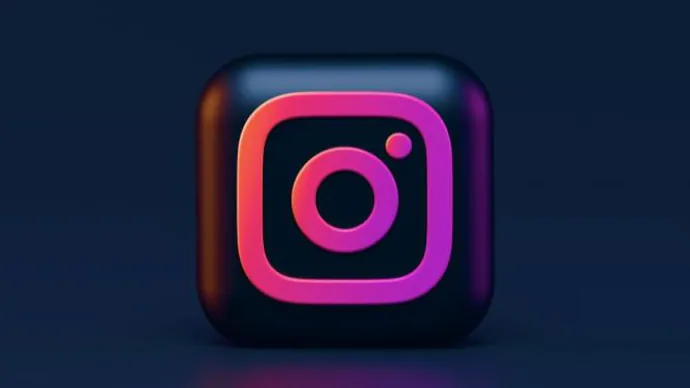Instagram business accounts have additional features that personal or influencer accounts lack, making them ideal for entrepreneurs looking to get their businesses off the ground. Analytics, in-app purchases, advertising, and external links are all features that can help propel your brand to the next level.
In addition, 50% of Instagram users look for local businesses, brands, and services through the app. So when it comes to expanding your customer base, increasing brand awareness, and generating leads, Instagram is a major player.
Luckily, setting up an Instagram account for your company is a breeze. In a matter of minutes, you can have your very own professional account. Let’s take a look at all you should think about when attempting to create one, the steps you should take to create it, and some tips for optimizing its use.
What Exactly Is an Instagram Business Account?
An Instagram business account informs Instagram that you are using the platform for marketing or business purposes, and it provides features that help you market your business and analyze your Instagram activity.
What Is the Difference Between a Personal Instagram Account and a Business Instagram Account?
The primary distinction between a personal Instagram account and a business Instagram account is that a business account offers a number of additional features that a personal account does not. Here are some of the additional features:
- The ability to incorporate swipe-up links into Stories (if the account has at least 10,000 followers)
- Possibility of boosting posts
- Posts that can be purchased
- Insights from Instagram
- Posts that can be promoted
- Contact information
- Automatic posting
In other words, you may need to consider your business and what you hope to achieve through Instagram when deciding whether to open a business account. Are you only using it to share content about your company and connect with followers? Or do you want to use it as a full marketing tool with analytics, insights, and other powerful features?
Also, examine your social media marketing strategy and consider which account type will best help you achieve your objectives.
The Benefits and Drawbacks of Having a Personal Instagram Account
Personal accounts are used by the majority of Instagram’s 1 billion registered users, making it an undeniably popular option. However, businesses frequently have different uses and goals for Instagram than personal users, so it’s important to weigh the advantages and disadvantages of each type of account. Although there are some advantages to using a personal account for your business, there are some significant disadvantages.
Benefits
Here are a few advantages of using a personal Instagram account for your business:
- Natural reach. The most significant advantage of using a personal account for business is knowing that if content performs well, it is because it is reaching your followers and they genuinely like and want to see it. All engagement is genuine and organic, and you won’t have to wonder if it came from a paid ad or boosted post.
- Connecting to multiple Facebook pages. A personal Instagram profile can connect to multiple Facebook pages, whereas a business account can only connect to one. If your company has multiple Facebook pages, such as those for different locations, a personal Instagram profile may be preferable.
- Going private. Another potential benefit of a personal account is the ability to make your profile private, which means Instagram followers must request to follow you and you must accept that request in order for them to see your content. This also means that your content will not appear in the Explore tab, nor will your posts appear in hashtag searches. This can be advantageous if you want to remain private and potentially entice your followers’ friends to join your follow list, but it can be detrimental if you want to broaden your reach and brand awareness.
Drawbacks
There are some drawbacks to using a personal Instagram account for business. Here are a few disadvantages:
- There are limited features. The most significant advantage of an Instagram business account is the wealth of features designed specifically for small businesses, which you do not have access to if you use a personal account. This can limit your potential for growth and decrease your chances of increasing brand awareness.
- Reduces your credibility. When people search for a business, they expect to see a business account, so using a personal account can be off-putting. It can also make your company appear less professional and raise doubts about its legitimacy.
The Benefits and Drawbacks of Having a Business Instagram Account
Multiple features of an Instagram business account can help your digital marketing strategy. However, there may be a few disadvantages to using a business account. Here are the benefits and drawbacks of having an Instagram business account.
Benefits
There are numerous advantages to using an Instagram business account:
Instagram Insights
Instagram Insights is its own analytics tool that provides detailed analyses of the following metrics:
- Details about the audience
- Tracking performance
- Storytelling performance
- Analytics for hashtags
- Increase your follower count.
- Performance of paid advertisements
- When is the best time of day to post?
- Rate of click-through
- Information for visitors
Instagram Insights provides useful data that can assist you in tailoring your posts and other Instagram content to better suit your audience and achieve your goals. For example, you can use Insights to determine which campaigns are the most effective, which types of posts perform best, and which stories generate the most engagement from your followers, all of which will help you drive more traffic and sales.
The Contact Button
A contact button is available in your account bio and provides information such as an email address, phone number, or physical address. This information gives your company credibility and makes it simple for potential customers to contact you.
Story Connections
If your business account has at least 10,000 followers, you can include swipe-up links in your stories. This means that any follower who watches your Stories can swipe up to any link you provide, such as a link to your website, a product, or a review. This allows you to easily direct followers to other websites rather than directing them out of the Instagram Story to click a link in your bio.
Instagram Advertisements
A business account allows you to create your own paid advertisements, which you can track using Insights. Instagram ads are an excellent way to raise brand awareness, broaden your reach, and target specific audiences.
Promoted Posts
Another feature unique to business accounts is the ability to boost or promote posts, which allows you to amplify a successful post by sending it to all of your followers, a recommended audience, or a targeted group of your choice. A boosted post appears as a sponsored post in the Instagram feeds of your followers.
Scheduled Posts
You can schedule posts on a business Instagram account, which can save you a lot of time and effort. However, keep in mind that you cannot schedule posts on Instagram; you must use a scheduler, such as Later.
Drawbacks
Although the disadvantages of business Instagram accounts are few, keep the following in mind:
- Feeling less personal. Because social media is all about engagement and making connections, an Instagram business profile may make followers less likely to engage with you than a personal profile, because they may perceive your account to be promotional.
- There is a chance that visibility will be reduced. If your followers’ feeds are dominated by businesses and Instagram influencers attempting to sell their wares, they may become overwhelmed and frustrated by the lack of organic content and unfollow business accounts. You can avoid this by keeping your promotional content to a minimum and aiming for an organic, natural tone while collaborating with an influencer who complements your brand.
- More work is required. “One disadvantage of a business account is that you have to manage it and continue to use man-hours to grow it,” Lamplugh explained. “Not being consistent and posting on a regular basis has a negative impact on the account’s performance.” In other words, your business Instagram requires more upkeep and planning (and money, if you have employees working on it) than your personal Instagram account, which you can update whenever you want without jeopardizing your business reputation or potential customers.
Should Your Instagram Account Be Personal Or Business?
There has been a lot of debate about whether brands and influencers are better off with personal Instagram accounts or business accounts. While each has benefits and drawbacks as outlined above, it appears that there is no one-size-fits-all solution for everyone. So, which is preferable for you? Here are some questions to consider:
Do you have a following of more than 10,000 people?
Whether you’re an influencer or have a small or large business, the number of followers you have is something to consider when deciding whether to have a personal or business account. Businesses with more than 10,000 followers can include a “swipe up” link in their Instagram stories. This feature has numerous advantages, such as driving traffic to your homepage, including an affiliate link to earn commission, or directing your audience to any direct call to action you wish for them to take.
Southwest Airlines, for example, recently discussed how Hurricane Florence may affect some airports. Southwest included a swipe-up link to its travel advisory homepage for those who may be affected to get more information. Similarly, Nordstrom shared its “Top 10 Trends for the Season” on Instagram Stories, along with a swipe-up link that took users directly to the point of purchase for each item. If your audience is 10,000 or larger, it may be sufficient reason to switch to a business profile, as this functionality is currently unavailable to personal accounts (or users below 10,000).
Would you find Instagram analytics useful?
For many, having specific insights into their Instagram audience is useful information. These data points are currently accessible only to business profiles. While third-party software is available to provide insights to any user, the convenience of monitoring this on a regular basis within the Instagram app is unquestionably a plus.
Users who want to know who their followers are, when they’re active on Instagram, and where they’re located (to name a few details) should switch to business profiles. You can use this valuable information to improve your content. For example, when our clients needed to make important announcements on Instagram, we carefully considered what day of the week and time their audience would be most active and likely to see this messaging, thanks to insights data.
Is maintaining a private account important to you?
For some, the ability to set their profile to private may be a security concern. If this is the case, the only way to enable it is through a personal account. Currently, business pages require that your page be public, so you may need to weigh the pros and cons of which matters more to you.
Do you need to connect to multiple Facebook pages?
If you need to connect your page to multiple Facebook accounts, you must create a personal page. Because Instagram and Facebook are owned by the same company, becoming a business account on Instagram requires you to link your account to a single corresponding Facebook page. If you run a restaurant group and have multiple Facebook pages for each of your restaurants, you won’t be able to link to each one from your Instagram if you want a business account.
Do you want to promote a blog post?
If you have a media budget (even a small one) and want to boost or promote one of your Instagram posts, you must be a business account. Personal accounts can certainly promote goods, services, or any other type of advertisement, but unless you switch to a business account, you won’t be able to control the reach by increasing it.
Are you willing to invest in your page in the long run?
While we can’t be certain, if Instagram follows in Facebook’s footsteps, it’ll only be a matter of time before business pages are required to fund their posts in order for the content to be seen.
As you can see from the reasons listed above, there are currently dozens of benefits and reasons why you should have a business page. With that said, if you’re not treating Instagram as a business in which you’d be willing to invest financially, you might want to think twice before making the switch.
Other questions to ask include the following:
- What’s your brand image? Is your personal brand the same as your professional brand, with you as the spokesperson or main figurehead?
- Is the core purpose of your business account to entertain and engage your audience, or is it to sell your products and/or services?
- Do you want to build brand awareness through a separate business account that’s easy to search for?
- Do you want to keep any content private? If so, make a new one—business accounts can’t have private content.
How to Create a Business Account on Instagram
If you don’t already have an Instagram account, you’ll create one and then convert it to a business profile. If you already have an Instagram account, converting it to a business account is simple.
Create a Fresh Instagram Account
If you don’t already have an Instagram account, follow these steps:
- On your smartphone or tablet, install the Instagram mobile app for iOS, Android, or Windows Phone. (You can also use a web browser to access Instagram, but its features are limited.)
- Click Sign up.
- Enter your email address. Use your business email or an email address designated for your company’s social media accounts. You can also use Facebook to log in if you already have a business account there.
- Select a username and a password.
- You now have a “personal” Instagram profile that you can turn into a business profile.
Convert Your Personal Instagram Account to a Business Account
It is simple to convert a personal account to a business profile.
- Tap your profile picture in the bottom right corner of Instagram.
- On the top right, tap Menu (three lines).
- Select Settings.
- Select Account.
- Scroll to the bottom and select Switch to Professional Account > Continue.
- Choose the business category that most accurately describes your company.
- Tap Done.
- Next, select Business. (Alternatively, if you’re a content creator or influencer, select Creator.)
- Examine your public business contact information and make any necessary changes. Click Next.
- Optionally, tap Login to Facebook and follow the on-screen instructions. Instagram recommends connecting to your Facebook Business Page in order to fully utilize Instagram’s business tools, such as boosting your posts and stories and setting up Instagram shopping.
- Complete your profile, choose other businesses to follow on Instagram, invite friends to follow your account, and explore professional tools like Insights (analytics about how your content is performing) and ad creation.
- To finish creating your professional profile, tap Done.
How to Use Instagram for Business
Instagram has a plethora of potential small business marketing tools in the form of posts, ads, and stories. Here are some fundamentals to help you get started with Instagram for business.
#1. Include professional-looking photographs
Because Instagram is a photo-sharing social media platform, it is critical to share visually appealing content. Generic photos will not suffice. Take photos, edit them, and take the time to ensure your Instagram grid is consistent.
To create a new photo post, follow these steps:
- At the top of your screen, tap Create (plus sign).
- Choose Post.
- To take a new photo, tap the camera icon, or choose one from your camera roll.
- To select filters and edit options, tap Next.
- Tap Next, then add a caption, tag people, and a location.
- You can optionally share the post on Facebook, Twitter, and Tumblr.
- Tap Advanced Settings to change the visibility of like and view counts, disable commenting, and more.
- When you’re done, tap Share to publish your photo post.
#2. Make use of Instagram Stories
Instagram Stories is a popular feature for both personal and business accounts. Instagram Stories are photos, videos, and other media that disappear 24 hours after they are posted.
Instagram Stories allows you to create a vibrant montage that can capture viewers’ attention and provide more information than a standard post. You can use recorded videos, still photos, live videos, boomerangs (back-and-forth videos), text, music, and focused photos.
Stickers can be used to display your location, temperature, user tags, and hashtags.
Create polls and invite questions to interact with your viewers, making it simple to collect valuable feedback. Some accounts, for example, use the questions feature to host a weekly Ask Me Anything session, which is a fun way to answer common questions.
Utilize Instagram’s Stories Highlights feature to create categorized stores that remain on your profile for viewers to watch later.
#3. Provide Live Video Streaming
In addition to Instagram Stories, users can record and stream live video that disappears, similar to how Facebook Live and Snapchat work. Give customers a behind-the-scenes look at exciting aspects of your business, show products, or respond to live questions in the comments.
After the video concludes, it will remain in your Instagram story for 24 hours. Upload a video you’ve taken or shoot one directly through the app to post if you want it to stay on your Instagram feed. You can still add filters and change the cover if you choose to shoot or upload a video.
#4. Communicate with your Followers
Instagram, like any other social media platform, requires you to engage and interact with your followers.
Liking is a simple way to connect with other users. To like a photo, double-tap it or tap the heart icon beneath the post.
- Commenting: To comment on a post, tap the comment icon (speech bubble), and the app will take you to the comments page for that post. Enter your comment in the text box, optionally add emojis, and then tap Post.
- Mentioning: Just like on Twitter, use the @ symbol in your Instagram comments or post captions to tag other users. They’ll be notified of the mention and may return to interact further.
- Tagging: Before and after posting content, Instagram allows you to add tags. To do so, before sharing your photo, tap Tag People and then tap where you want the tag to appear in the photo. To find the person’s account, the app prompts you to enter their name. When you tag people in a photo and share it, other users can view the tagged people by tapping on the photo.
- Direct Message: To access Instagram Direct, go to your home page and tap the Messenger icon in the top right corner. (Instagram integrates Facebook Messenger.) Send private instant messages to other users, including photos and videos. Tap the notepad button in the top right corner and search for the person or business you want to contact to send a new direct message. After you’ve sent the message, you and the recipients can exchange messages. Before they can view your DM, users who are not already following you will be asked if they want you to send them photos and videos.
#5. Make Use of hashtags
Hashtags are an excellent way for Instagram users to find content. Hashtags can contain both letters and numbers, but no non-numerical characters. #DaveAndBusters, for example, works as a hashtag, but #Dave&Busters does not.
Relevant hashtags can be a highly effective tool for getting noticed because users can search for hashtags and click on hashtags they see in posts. However, ensure that you’re using the appropriate hashtags for your brand.
Follow these hashtag best practices:
- Use appropriate hashtags. Hashtags like #nofilter (a photo without filters), #selfie (a picture of yourself), and #tbt or #throwbackthursday (old photos) are popular on Instagram, but they may not work for you or your brand. Look for hashtag examples from other established brands, users, and bloggers in your industry.
- Avoid using too many hashtags. Instagram allows up to 30 hashtags in a post or comment (and up to 10 in an Instagram story), but that is far too many. The fewer hashtags you can use to receive high-quality responses, the better. Using a lot of popular hashtags may get you a lot of likes from other users, but it’s unlikely to increase your following much, and the interactions you get will most likely be from people who saw and liked your image, rather than those who are interested in your brand.
- Play around with hashtags. Once you’ve figured out what hashtags are, branch out and experiment to see which ones work best for your brand. It’s also a good idea to create a unique hashtag for your company or event. Customers can follow along with an event even if they aren’t physically present.
#6. Make use of Instagram Reels
Instagram Reels are brief, entertaining videos that can assist you in bringing your brand to life. Provide a behind-the-scenes tour or demonstrate how your product is made. Add transitions and effects, tag products from your catalog, highlight paid partnerships, and more.
Reels are an excellent way to create a campaign for a specific target customer or to expand on the product or service focus of an Instagram story.
To start creating a Reel, go to your home page and select Create (plus sign).
#7. Promote yourself on Instagram
Businesses, like those on other social media platforms, can advertise on Instagram. You have a few options to think about.
You can create a new Instagram ad in one of three formats: photo, video, or carousel.
Photo ads resemble regular photo posts but have a Sponsored label above the photo. They also have a call-to-action button in the lower right corner of the image. Many photo ads are boosted posts, in which you pay to increase the reach of an existing post.
Video ads: These, like photo ads, appear as regular video posts but with a Sponsored label on top.
Carousel ads resemble photo ads but feature multiple photos that users can swipe through.
Of course, there are other ways to advertise on Instagram.
- Instagram Stories ads: Instagram Stories ads appear when users scroll through the stories of other accounts. Because Stories ads take up the entire device screen, use a visually appealing image.
- Collection ads: This includes a main image and a product catalog at the bottom. This is a great way to entice viewers to learn more about your products.
- Explore ads: Explore ads appear on a user’s Explore page, where Instagram displays posts that may be of interest to them. Explore ads are an excellent way to get your brand in front of people who are likely to be interested in it.
Meanwhile, you can advertise on Instagram using either the Instagram app or the Facebook Ads Manager (if your account is connected to your business Facebook Page). Both options allow you to choose your ad’s objective, audience base, budget, and length of time it will run. The Ads Manager on Facebook provides additional configuration, formatting, and demographic options.
#8. Gather audience feedback
Anyone with a business account has access to information about their audience and levels of engagement. To see metrics on your followers and their activity with your content, open the menu in your Instagram business account and tap Insights. Tap View Insights on any individual post to see metrics for that post.
Insights data can help you optimize your posting schedule, pinpoint your target audience, and figure out what works.
#9. Use Instagram to sell products
Instagram is an excellent place to begin selling online. Instagram added the Shop tab in November 2020, allowing users to discover and purchase products from brands directly through the app. Instagram’s Shop feature is most likely a reaction to the continued growth of social media and mobile shopping.
You can sell your products by adding product tags to your posts, stories, and reels, or you can create shoppable posts by adding product tags to your posts, stories, and reels.
To begin shopping on Instagram, follow these steps:
- Connect your Instagram company account to your Facebook company page.
- Confirm that Instagram is compatible with your market.
- Choose whether you want to use Facebook’s Commerce Manager or a supported partner like Shopify to set up shop.
- Create a store in Commerce Manager or on your platform.
- Users must enter their name, email address, billing information, and shipping address to complete a transaction. Instagram’s parent company, Meta, will save that information for future transactions. Payment methods include Visa, Mastercard, American Express, Discover, and PayPal.
Related Articles
- INSTAGRAM MARKETING 2023 Guide & Strategies (Updated)
- INSTAGRAM MANAGEMENT TOOLS: Uses, Free Tools & Pricing
- How To Market Your Business Anywhere: 2023 Ideas & Tips
- HOW TO MAKE MONEY ON INSTAGRAM IN 2023: Top 7 Ways
- HOW TO USE INSTAGRAM FOR BUSINESS






